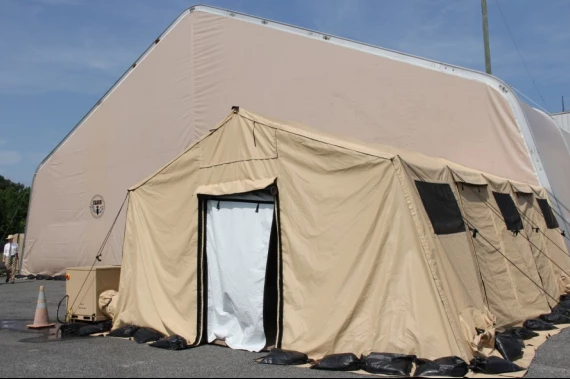With Syria recently announcing that it will accept a Russian plan to place their chemical weapons under Russian and international control, the world will breathe a collective sigh of relief. But this is by no means the end of the story. What is likely to happen to the lethal gases, nerve agents and their precursors once they are handed over?
In June, the US Department of Defense rolled out a system to rapidly deploy chemical weapons disposal facilities that could potentially be used quickly and effectively on foreign shores in the near future. The Field Deployable Hydrolysis System (FDHS) developed at the US Army's Edgewood Chemical and Biological Center in Maryland is a mobile system designed to destroy chemical warfare agents in bulk. The FDHS neutralizes chemical agents by mixing them with water and other reagents like sodium hydroxide and sodium hypochlorite and then heating them to produce compounds that are "not usable as weapons." This heating and mixing process to facilitate chemical reactions purportedly has destruction efficiency of 99.9 percent.

Manned by a crew of 15 trained technicians at any given time, the FDHS has the potential to neutralize between five and 25 metric tons of chemicals per day. The whole package is transportable and entirely self-sufficient. Critical components have built in redundancy (by building in duplicate backup systems) as a fail-safe and to ensure uninterrupted operation.
At the heart of the FDHS is a hydrolysis system with a 2,200 gallon (8,328 liter) titanium reactor, capable of daisy chaining with additional reactors to increase throughput rates. Ventilation of the working enclosure is handled by chemical agent filtration systems that provide air exchanges and removal of any lethal vapor and fumes.
A personnel decontamination station, with dedicated air-conditioning, ensures a controlled entry and exit into the operations area. It also serves as a launch pad for emergency response teams to enter the enclosure in the event of any chemical leaks or spillage.
Chemical warfare agents are divided into two major groups defined by their horrendous effects on humans and animals. The first category, the G-type group, includes the nerve agents sarin, soman, tabun, and VX. The second category consists of blistering agents lewisite and sulfur mustard gas. The FDHS can decommission both categories and also the components that go into making them.
Correctly analyzing chemical agents prior to processing and verification of their destruction post reaction is an essential part of the FDHS. To this end, a laboratory is housed in a 20-foot expandable structure equipped with gas chromatography–mass spectrometry equipment, a ventilated glove box, a fume hood, and a whole range of sophisticated equipment for analysis and data management.
The FDHS also incorporates a heating system to rapidly heat water up to 90º C (a requirement in certain decommissioning processes of mustard gas), storage facilities for reagents, pumps, compressors, tanks and electrical generators to keep the entire operation powered up. The US Army also has access to mobile detonation chambers, such as the T-30 transportable detonation chamber, that can be used in conjunction with the FDHS in the field.
Both America and Russia, along with 187 other countries, have been destroying their stockpile of chemical weapons since signing the Chemical Weapons Convention (CWC) agreement in 1993. Neither country, however, has managed to keep on schedule with the decommissioning deadlines, mainly due to technical, political and environmental issues. Total eradication of chemical weapons in Russia may not occur until 2027, and in the US the revised deadline has been moved back to 2023.
Syria, one of only seven countries that did not sign the CWC agreement according to the CIA, has continued to manufacture sarin, tabun, VX, and mustard gas. The Secretary of State John Kerry said recently that Syria's chemical agents amounted to 1,000 tons, the majority of which are in storage tanks unmixed.
The FDHS isn't the only option for the disposal of chemical weapons, but should transportation difficulties or other practicalities prevent permanent disposal facilities being used (in the case of Syria or elsewhere), it may be that the FDHS sees use in the not so distant future.
Source: U.S. Army Research Development and Engineering Command, Chemical & Biological Center
















